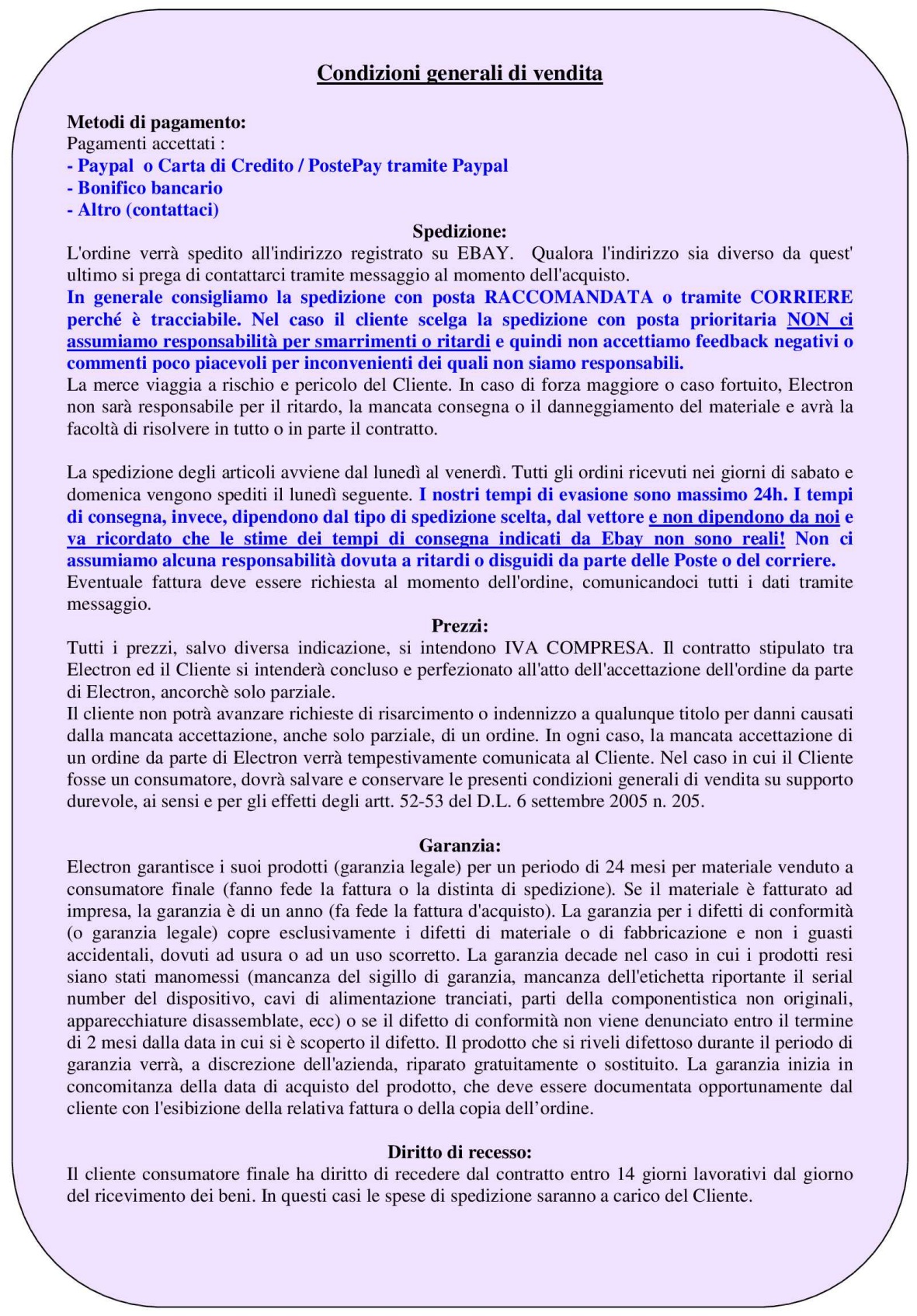


Se acquisti più pezzi di questo articolo, potresti risparmiare sulla spedizione!
Riempi il carrello e clicca sul pulsante 'RICHIEDI IL TOTALE AL VENDITORE' o contattaci per offerta personalizzata!
Convertitore universale DC-DC step down
LM2596S regolabile
Con corrente in uscita tarabile da 0 a 3 Amp
Lo scopo di questo convertitore è quella di abbassare la tensione di ingresso e stabilizzarla.
Inoltre, disponendo della regolazione della corrente in uscita è utile come alimentatore per dispositivi a LEDs
o dispositivi che necessitano di limitare la corrente massima.
o per usare come caricabatteria a corrente costante o tensione costante ( batt. NI-MH o al piombo).
V in : 7V - 32V (limitata da V CE in)
Vout: regolabile da 1,8V a 30V (la tensione di uscita minima non può essere minore di 1,8V pena l'instabilità della corrente di uscita)
Corrente uscita : regolabile da 0 a 3A
Potenza trasferibile : fino a 15W senza dissipatore ( se maggiore applicare dissipatore)
Efficenza : fino al 92%
Dimensioni totali = 48x24x14
Peso = 13 gr
Uso trimmers ( senso orario= aumenta; antiorario = diminuisce ) :
Trimmer 'V' ( tensione) : regola il valore della tensione di uscita Vout.
Trimmer 'I' ( corrente) : regola il valore della corrente massima in uscita Imax.
Trimmer 'CH' ( stato carica ) : regola la soglia di accensione del led 'CH' ( tarabile circa nel range 1/10 Imax ).
Il suo uso è opzionale . Il valore di questa soglia va trovato sperimentalmente o utilizzando un aperometro in serie al carico.
Di solito si usa quando il DC-DC viene utilizzato per caricare una batteria; impostando il valore opportuno la spia 'CH' rimane accesa finchè la batteria è in piena fase di carica e assorbe molta corrente e si spegnerà quando la batteria è praticamente carica e la corrente di carica si sta avvicinando a valori molto bassi.
Leds:
'OK' : si accende a vuoto o quando i led CV/CC e CH sono spenti.
'CV/CC ' : si accende quando la corrente assorbita in uscita supera il limite Imax impostato ( o in caso di corto circuito).
'CH' : indica la fase di carica della batteria ( vedi note trimmer 'CH')
_______________________________________________________________________________
LINK for usage: HTTP://sites.google.com/site/3dprinterlist/electronics/chinese-electronics/lm2596-buck-converter-charger-cc-cv
Description:
- Input Voltage: 5-32V
- Output Voltage: Continuously adjustable from 1.8 V to 30V
- Minimun Voltage difference : 2V
- Rated Output Current: 3A
- Max. Output Current: 4A (more than 15W, preferably with a heat sink or if temperature > 45° )
- Load regulation : +- 1%
- Voltage regulation : +- 0,5%
- Size (L x W x H): Approx. 1.9 x 0.95 x 0.5 inch / 4.8 x 2.4 x 1.3cm
- No-load Current: Typical 10mA
- Dynamic response speed: 5% 200uS
- Adjustment: Apply to 5-35V power source, use multimeter to test the oputput voltage and then adjust the potentiometer, turn clockwise to step up and counterclockwise to step down
- Indicator Light
- Constant current indicator(red)
- Charging indicator(red)
- Charged full (green)
Applications:
- High-power LED constant current drive
- Lithium battery charger (including ferroelectric)
- 4V, 6V, 12V, 14V, 24V battery charger
- Nickel cadmium, nickel metal hydride battery pack charger
- Solar panels and wind turbines
Battery Use:
- Make sure of the voltage and current of the battery you need to charge
- Adjust the constant voltage potentiometer to make the output voltage same to the charge voltage
- Potentiometer Adjustment Direction: Clockwise (increase), counterclockwise (decrease)
- Use the multimeter in 10A current scale to measure output short-circuit current, and adjust the current potentiometer to make sure the output current to the expected charging current value
- The charge current of transfer lamp is default 0.1 times of the charging current (constant current value)
- Connected to the battery and try to charging (for previous 5 steps, module input terminal is connected to power source, output load is NOT connected to batteries)
LED Constant Current Driver Use:
- Make sure operating current and Max operating Voltage of the LED you need to drive
- Adjust the constant voltage potentiometer to make sure the output Voltage is up to LED Max operating Voltage
- Use the multimeter in 10A current scale to measure output short-circuit current, and adjust the current potentiometer to make sure the output current to the expected LED operating current
- Join LED, test (For the above 3 steps, module input terminal is connected to power source, output load is NOT connected to LED)
Peso conf: 13,2 gr


